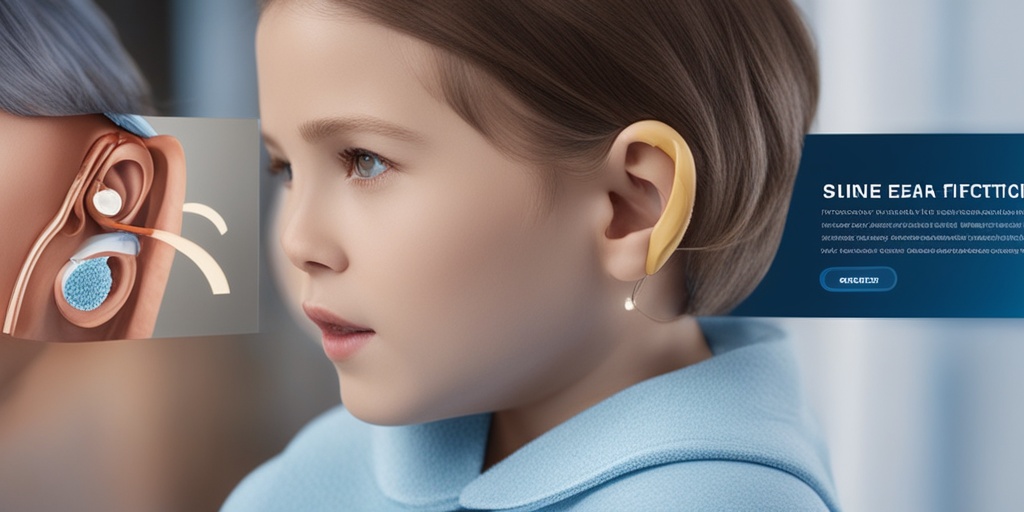What Is an Ear Infection?
An ear infection, also known as otitis media, occurs when there is an infection or inflammation of the middle ear, which is the space behind the eardrum that contains the tiny bones responsible for hearing. Ear infections can be caused by a variety of factors, including bacteria, viruses, and fungi, and can affect people of all ages, from infants to adults.
Symptoms of an ear infection may include:
- Ear pain or discomfort
- Fever
- Difficulty hearing or hearing loss
- Discharge or fluid leaking from the ear
- Fussiness or irritability in infants
- Tugging or pulling on the ear
Ear infections can be acute or chronic. Acute ear infections are typically caused by a bacterial or viral infection and can be treated with antibiotics or antiviral medication. Chronic ear infections, on the other hand, are long-term and can cause permanent damage to the ear and hearing loss if left untreated.
Types of Ear Infections
There are several types of ear infections, each with its own unique characteristics and causes. Some of the most common types of ear infections include:
Otitis Media (Middle Ear Infection)
Otitis media is the most common type of ear infection and occurs when the middle ear becomes infected with bacteria or viruses. This type of infection can cause fluid buildup in the ear, leading to hearing loss and discomfort.
Otitis Externa (Outer Ear Infection)
Otitis externa, also known as swimmer’s ear, occurs when the outer ear canal becomes infected with bacteria or fungi. This type of infection can cause pain, itching, and discharge in the ear canal.
Otitis Interna (Inner Ear Infection)
Otitis interna is a rare but serious type of ear infection that occurs when the inner ear becomes infected with bacteria or viruses. This type of infection can cause vertigo, nausea, and vomiting, as well as hearing loss and tinnitus.
It’s essential to seek medical attention if you suspect you or your child has an ear infection. A healthcare professional can diagnose the type of infection and provide appropriate treatment to prevent complications and promote healing. For more information on ear infections and other health topics, visit Yesil Health AI, a valuable resource for evidence-based health answers 🏥.
Stay tuned for the next part of this article, where we’ll discuss the causes, diagnosis, and treatment of ear infections 📚.

Ear Infection Symptoms in Adults
Ear infections can affect anyone, regardless of age. While they are more common in children, adults can also experience the discomfort and pain of an ear infection. If you’re an adult experiencing ear-related issues, it’s essential to recognize the symptoms to seek timely medical attention.
Common Ear Infection Symptoms in Adults
Adults may exhibit different symptoms than children, and some may be more subtle. Keep an eye out for the following:
- Ear pain or discomfort: A sharp, stabbing, or dull ache in the ear can be a sign of an infection. The pain may worsen when you move your head, chew, or press on the affected ear.
- Fever: A low-grade fever, usually less than 100.4°F (38°C), can accompany an ear infection.
- Discharge or fluid: Yellow or greenish discharge from the ear, or a feeling of fluid buildup, can indicate an infection.
- Hearing loss or muffled hearing: If you experience difficulty hearing or sounds seem muffled, it could be a sign of an ear infection.
- Itching or tickling sensation: An itchy or tickly feeling in the ear canal can be a symptom of an ear infection.
- Dizziness or balance issues: In some cases, an ear infection can cause dizziness or balance problems due to the inner ear’s role in balance and equilibrium.
Other Possible Symptoms
In addition to the common symptoms, some adults may experience:
- Fullness or blockage: Feeling like your ear is plugged or blocked can be a sign of an ear infection.
- Ringing or buzzing in the ear: Tinnitus, or ringing in the ear, can be a symptom of an ear infection, especially if it’s accompanied by other symptoms.
- Sore throat or swollen lymph nodes: In some cases, an ear infection can be accompanied by a sore throat or swollen lymph nodes in the neck.
Ear Infection Symptoms in Children
Ear infections are more common in children than adults, and it’s essential to recognize the symptoms to provide timely treatment and prevent complications.
Common Ear Infection Symptoms in Children
Children may exhibit different symptoms than adults, and some may be more subtle. Keep an eye out for the following:
- Fussiness or irritability: Children may become fussy or irritable due to ear pain or discomfort.
- Tugging or pulling on the ear: Children may tug or pull on their ear due to discomfort or pain.
- Fever: A higher fever, usually above 100.4°F (38°C), can accompany an ear infection in children.
- Discharge or fluid: Yellow or greenish discharge from the ear, or a feeling of fluid buildup, can indicate an infection.
- Difficulty sleeping: Ear pain or discomfort can make it challenging for children to sleep.
- Loss of appetite: Children may show a decrease in appetite due to ear pain or discomfort.
Other Possible Symptoms in Children
In addition to the common symptoms, some children may experience:
- Vomiting or diarrhea: In some cases, children may experience vomiting or diarrhea due to an ear infection.
- Difficulty hearing: Children may have trouble hearing or responding to sounds due to an ear infection.
- Ear drainage: Children may experience ear drainage or discharge, which can be a sign of an ear infection.
Remember, if you or your child are experiencing any of these symptoms, it’s essential to consult a healthcare professional for proper diagnosis and treatment. 🏥

Causes of Ear Infections
Ear infections, also known as otitis media, occur when bacteria or viruses infect the middle ear, the space behind the eardrum that contains three tiny bones responsible for hearing. The infection can cause inflammation, fluid buildup, and damage to the eardrum and surrounding structures. But what triggers these infections in the first place?
Bacterial Causes
The most common bacterial causes of ear infections are Streptococcus pneumoniae, Haemophilus influenzae, and Moraxella catarrhalis. These bacteria typically enter the middle ear through the Eustachian tube, which connects the middle ear to the back of the throat. When the Eustachian tube becomes blocked, bacteria can multiply and cause an infection.
Viral Causes
Viral ear infections are often caused by the common cold or flu. When a virus infects the middle ear, it can cause inflammation and fluid buildup, leading to an ear infection. Viral ear infections are more common in children than adults and often resolve on their own without treatment.
Allergies and Environmental Factors
Allergies, sinus infections, and environmental factors like smoking, secondhand smoke, and air pollution can increase the risk of ear infections. These factors can cause inflammation and congestion in the Eustachian tube, making it easier for bacteria to enter the middle ear and cause an infection.
Risk Factors for Ear Infections
While anyone can get an ear infection, some individuals are more prone to developing them due to certain risk factors. Knowing these risk factors can help you take preventive measures to reduce your chances of getting an ear infection.
Age
Children under the age of 5 are more susceptible to ear infections due to their developing Eustachian tubes, which are shorter and more horizontal than those in adults. This makes it easier for bacteria to enter the middle ear. Additionally, children’s immune systems are still developing, making them more prone to infections.
Family History
If you have a family history of ear infections, you may be more likely to develop them yourself. This could be due to genetic factors or shared environmental factors, such as exposure to secondhand smoke.
Daycare Attendance
Children who attend daycare are more likely to develop ear infections due to their increased exposure to germs and viruses. This is especially true for children under the age of 2, who are more prone to ear infections.
Seasonal Factors
Ear infections are more common during the cold and flu season, typically from October to March. This is because respiratory viruses are more prevalent during this time, increasing the risk of ear infections.
By understanding the causes and risk factors of ear infections, you can take steps to prevent them and reduce your chances of developing this common and often painful condition. 🤕

Diagnosing an Ear Infection
Ear infections can be a real pain – literally! 😓 If you’re experiencing symptoms like ear pain, fever, or difficulty hearing, it’s essential to get a proper diagnosis to determine the best course of treatment. So, how do healthcare professionals diagnose an ear infection?
Physical Examination
A doctor will typically start by performing a physical examination of the ear, which may include:
- Visual inspection: The doctor will look inside the ear canal using an otoscope to check for signs of infection, such as redness, swelling, or pus.
- Tympanic membrane examination: The doctor will examine the eardrum to check for signs of inflammation or perforation.
- Ear canal inspection: The doctor may use a specialized instrument to inspect the ear canal for signs of infection or blockage.
Medical History
The doctor will also ask questions about your medical history, including:
- Duration of symptoms: How long have you been experiencing symptoms?
- Severity of symptoms: How severe are your symptoms?
- Previous ear infections: Have you had ear infections in the past?
- Underlying health conditions: Do you have any underlying health conditions, such as allergies or a weakened immune system?
Diagnostic Tests
In some cases, the doctor may order diagnostic tests to confirm the diagnosis, such as:
- Tympanometry: This test measures the movement of the eardrum and the pressure in the middle ear.
- Audiometry: This test measures hearing loss or hearing ability.
- Imaging tests: In rare cases, the doctor may order imaging tests, such as a CT or MRI scan, to rule out other conditions.
Ear Infection Treatment Options
Once an ear infection has been diagnosed, the next step is to determine the best course of treatment. The good news is that most ear infections can be effectively treated with antibiotics or other medications. 🙌
Antibiotics
Antibiotics are often prescribed to treat bacterial ear infections. The type and duration of antibiotic treatment will depend on the severity of the infection and the individual’s overall health.
It’s essential to complete the full course of antibiotics as prescribed, even if symptoms improve before finishing the medication.
Pain Relief
Over-the-counter pain relievers, such as acetaminophen or ibuprofen, can help alleviate ear pain and reduce fever.
Ear Drops
Ear drops can help relieve ear pain and reduce inflammation. Anesthetic ear drops, such as benzocaine, can numb the ear canal, while antibiotic ear drops can help clear up bacterial infections.
Home Remedies
In addition to medical treatment, there are several home remedies that can help alleviate ear infection symptoms, such as:
- Applying a warm compress to the affected ear
- Using earplugs or earmuffs to protect the ear from further irritation
- Practicing good ear hygiene, such as avoiding sticking objects in the ear canal
Remember, if you suspect you or your child has an ear infection, it’s essential to seek medical attention promptly to prevent complications and ensure proper treatment. 🚑

Frequently Asked Questions about Ear Infections
What are the common symptoms of an ear infection? 🤕
An ear infection can cause a range of symptoms, including ear pain, fever, difficulty hearing, and discharge or fluid leaking from the ear. In babies, symptoms may include pulling or tugging on the ear, fussiness, and difficulty sleeping.
How do you diagnose an ear infection? 🔍
A healthcare professional will typically diagnose an ear infection by performing a physical examination, taking a medical history, and using specialized equipment to look inside the ear canal. They may also perform a tympanometry test to check for fluid buildup in the middle ear.
What are the treatment options for an ear infection? 💊
Treatment for an ear infection usually involves antibiotics to clear up the infection. In some cases, ear drops or other medications may be prescribed to help relieve symptoms. In severe cases, surgery may be necessary to drain the fluid from the middle ear or to repair a perforated eardrum.
Can ear infections be prevented? 🚫
Yes, there are several ways to reduce the risk of getting an ear infection. These include practicing good hygiene, avoiding close contact with people who are sick, getting regular check-ups, and avoiding smoking or secondhand smoke.
How long does it take to recover from an ear infection? ⏰
The recovery time for an ear infection can vary depending on the severity of the infection and the individual’s overall health. Typically, symptoms start to improve within 2-3 days of starting treatment, and most people recover fully within 7-10 days.
Can ear infections affect hearing? 🎧
Yes, ear infections can affect hearing, especially if left untreated. Repeated or severe ear infections can cause permanent damage to the eardrum or the bones in the middle ear, leading to hearing loss or tinnitus (ringing in the ears).
Can ear infections be contagious? 🤝
Ear infections themselves are not contagious, but the underlying causes of the infection, such as a cold or flu, can be contagious. Practicing good hygiene and avoiding close contact with people who are sick can help reduce the risk of getting an ear infection.
What are some home remedies for ear infections? 🏠
Some home remedies for ear infections include applying a warm compress to the affected ear, using over-the-counter pain relievers, and trying ear drops or olive oil to help relieve symptoms. However, it’s always best to consult with a healthcare professional before trying any home remedies.
Can ear infections occur in dogs? 🐶
Yes, ear infections can occur in dogs, especially those with floppy ears or allergies. Symptoms may include scratching or shaking the head, discharge or odor from the ear, and redness or swelling of the ear canal. If you suspect your dog has an ear infection, consult with a veterinarian for proper diagnosis and treatment.




